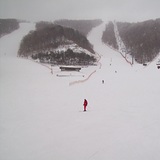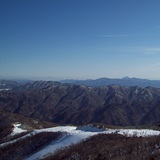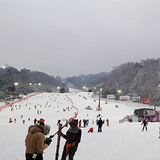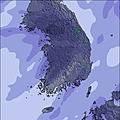 Ski South Korea
Ski South Korea
Sandwiched between China across the sea to the West, Japan across the sea to the east and with North Korea the only country to which it is connected over land, South Korea is a country where a number of relatively low level mountain ranges succeed one another across its land mass.
The Taebaek, Sobaek and Jiri mountains are the country’s three main ranges, with the highest peak in South Korea, Hallasan (1,950m), actually the cone of a volcanic formation that forms Jeju Island to the south of the mainland.
The country is famous for its normally cold winters which can usually be relied upon to bring moderate snowfall, and cold enough temperatures for snowmaking, from December to March.
The vast majority of south Korea’s ski areas are located in the north of the country in Gangwon-do province, the area that receives the most annual snowfall.
There are a few areas located outside this region however, with Eden Valley Resort located on Sinbulsan Mountain in the South Gyeongsang Province the country’s most southerly.
Organised downhill skiing developed rather late in South Korea with the first resort developments beginning in the mid-1970s. However the rise of popularity of winter sports was fairly meteoric and whilst there remain only around 20 ski areas in the country, by the late 1990s South Korea was already considering biding to host the Winter Olympics and was a close runner up to Vancouver for 2010 and Sochi for 2014 before finally winning the right to stage the 2018 Games in Pyeongchang.
South Korea also did not suffer from the sudden decrease in interest in winter sports that effected Japan in the early 1990s after the collapse of the ‘bubble economy’ there.
South Korean ski areas may be relatively few in number but they are very heavily developed facilities in most cases, with many other year-round activities offered besides skiing and snowboarding, and extensive accommodation options on site. Most are easy to reach from major cities including the capital Seoul. Floodlighting of pistes is also common to allow for skiing from early in the morning to late at night. Peak season is from mid-December to mid-February and rooms tend to get booked up well in advance during these two months.
Muju, one of Korea’s largest resorts with 15 chairlifts for example, is alkso home to the country’s largest tennis complex with no less than 108 courts, a lake for water sports, an Arnold palmer designed 18 hole golf course and country club and many other sporting facilities including horseback and mountain bike riding trails. There’s also the Cinderella Beauty Palace, a cinema park, an artist village covering all forms of art, a Korean cultural theme park and a branch of the Russian Tchaikovsky Music Institution.
Muju’s huge 742-bedroom Hotel Tirol complex, themed on an Alpine resort, includes a grand ballroom capable of holding 700 people with a five-language simultaneous translation system in place.
Although Muju perhaps offers more non-ski/board options than any other Korean ski area, it is typical of the variety of activities available in the country’s resorts, and how winter sports are often regarded as one of many activities offered, rather than the main activity.
2018 Winter Olympics and Paralympics
Most events at the 2018 Games are set to take place in the existing resorts of Alpensia (Nordic events) and Yongpyong (Slalom and Giant Slalom).
Special venues are being created to host freestyle skiing and snowboarding at Bokwang Snow Park and for Downhill, Super-G, and Combined Alpine events, the new Jeongseon Alpine Centre.
The Jeongseon Alpine Centre has had to be created because South Korea lacked any existing ski area with a lift served vertical of more than the 800 metres required for the Downhill under International Olympic Committee (IOC) rules (the largest existing vertical was 702m at Yongpyong ski area, with most areas only having 200—400m verticals). However the development of the course here, which will have an 880m vertical, has proved controversial as the course is being cut through natural parkland and old forest, leading to protests from environmental groups. They suggested that building an artificial addition to the top of the slope at Yongpyong to provide the vertical required, perhaps also requesting exceptional permission from the IOC to reduce the required size of the vertical slightly, was a better option in their opinion.
The decision to stage the Winter Olympics in South Korea is also popularly credited in Western media as being part of the reason why North Korea decided to develop their own ski area at Masik Pass which opened for the 2013-14 ski season, although there were several smaller basic ski areas existing in North Korea before this high profile project.
North Korea actually has the higher mountains in the Korean peninsular. At 2,744 m (9,003 ft), Paektu, Baekdu, or Changbai Mountain, an active volcano on the border with China, is North Korea’s highest mountain and revered in the country as the birth place of ‘great leader’ Kim Jong Il. Chinsa has developed several ski resorts on its side of the mountain.
The Pyeongchang Winter Olympics will take place from 9 - 25 February 2018 with the Winter Paralympic Games taking place from 9 – 18 March 2018 (http://pyeongchang2018.com/horizon/eng/index.asp).
South Korea: latest snow conditions round-up
Summary of forecast snowfall and ski conditions for resorts in South Korea. Fresh snow is forecast at 14 resorts. Powder is reported at 0 resorts and 0 are reporting good piste conditions.
All resorts
Ski resorts of South Korea, alphabetically
| Resort |
|
snow depth top and bottom |
on-piste |
off-piste |
Last Snow |
Next 9 Days 0–3 | 3–6 | 6–9 snow (cm) |
Freezing level (m) |
||||||||||||||||||||||
|---|---|---|---|---|---|---|---|---|---|---|---|---|---|---|---|---|---|---|---|---|---|---|---|---|---|---|---|---|---|
| Fri | Sat | Sun | Mon | Tue | |||||||||||||||||||||||||
|
(300 m — 629 m) snow report 4 days ago |
|
|
|||||||||||||||||||||||||||
|
(300 m — 379 m) snow report 4 days ago |
|
|
|||||||||||||||||||||||||||
|
(200 m — 399 m) snow report 5 days ago |
|
|
|||||||||||||||||||||||||||
|
(300 m — 473 m) snow report 4 days ago |
|
|
|||||||||||||||||||||||||||
|
(680 m — 1367 m) snow report 4 days ago |
|
|
|||||||||||||||||||||||||||
|
(99 m — 303 m) snow report 4 days ago |
|
|
|||||||||||||||||||||||||||
|
(177 m — 497 m) snow report 4 days ago |
|
|
|||||||||||||||||||||||||||
|
(800 m — 1614 m) snow report 3 days ago |
|
|
|||||||||||||||||||||||||||
|
(1100 m — 1420 m) snow report 3 days ago |
|
|
|||||||||||||||||||||||||||
|
(172 m — 434 m) snow report 4 days ago |
|
|
|||||||||||||||||||||||||||
|
(681 m — 1080 m) snow report 4 days ago |
|
|
|||||||||||||||||||||||||||
|
(700 m — 900 m) snow report 4 days ago |
|
|
|||||||||||||||||||||||||||
|
(680 m — 1080 m) snow report 4 days ago |
|
|
|||||||||||||||||||||||||||
|
(545 m — 1370 m) snow report 4 days ago |
|
|
|||||||||||||||||||||||||||
|
(756 m — 1458 m) snow report 4 days ago |
|
|
|||||||||||||||||||||||||||
|
(250 m — 450 m) snow report 4 days ago |
|
|
|||||||||||||||||||||||||||
|
(310 m — 580 m) snow report 4 days ago |
|
|
|||||||||||||||||||||||||||
|
(573 m — 896 m) snow report 4 days ago |
|
|
|||||||||||||||||||||||||||
|
(81 m — 230 m) snow report 4 days ago |
|
|
|||||||||||||||||||||||||||







